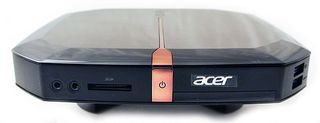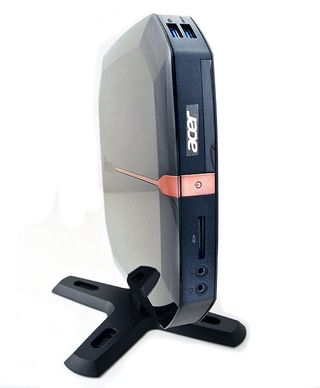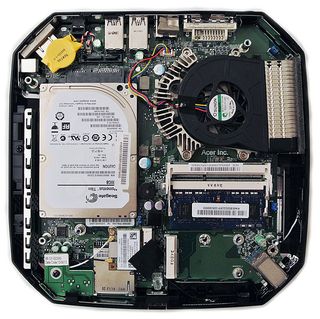Seven Small (But Powerful) Mini-PCs, Reviewed
Acer Revo RL80-UR22
Acer introduced its Aspire Revo series in 2009, starting with the Atom 230-equipped R1600. Like most nettops at the time, it was underpowered, but provided passable service in the most basic workloads. The RL80 we're looking at today is quite a bit different; it introduces some much-needed compute potential through an Ivy Bridge-based Core i3-3227U.
Running at 1.9 GHz, only two products in this round-up operate at a lower clock rate, but one also peaks with a 2.6 GHz Turbo Boost setting. The Revo doesn't have Turbo Boost enabled, so we expect it to bring up the rear in most of our CPU benchmarks. The on-die HD Graphics 4000 engine pretty much par in this group, and we know it to be capable of fairly mainstream gaming aspirations.
Priced at $430 on Newegg, including an operating system, the RL80's biggest selling point is a massive price advantage compared to the rest of the playing field.
Bundle And First Impression

Of the companies involved in our round-up, Acer is the most well-known as a system vendor, rather than a component manufacturer. This becomes evident in the bundle: the Revo RL80 is the only PC in this comparison that includes a wireless mouse, a wireless keyboard, and an operating system. Just hook up a display and you're good to go.

The system can sit horizontally or mount vertically. At 8.3" x 8.3" x 1.4" and 2.2 lbs, it's one of the larger mini-PCs in our story. But it's still small and light enough to attach to the back of a monitor, thanks to a VESA-compatible base.

There's not a lot to see up front except for two USB 3.0 ports, a memory card reader, and audio input/output jacks.

Most of the connectivity is found around back. You get HDMI and DVI outputs, two USB 2.0 and two USB 3.0 ports, an optical audio output, and a GbE jack, which isn't visible because it occupies the bottom corner.

A single screw holds the plastic cover down, although some force is required to pop it off. After that, remove a thin layer of metal for access to the hardware underneath.
First off, we notice that Acer's mini-PC has two memory slots for a dual-channel configuration, but only comes equipped with one 4 GB SO-DIMM. You can also see one mini-PCIe slot populated by the Atheros AR5B22 802.11n/Bluetooth 4.0 combo card. There's another mini-PCIe slot on the other side, which looks like it should be able to take an mSATA-based SSD, except that it doesn't. Only another mini-PCIe peripheral will work there.
On the left is the bundled Seagate Momentus Thin 500 GB hard disk with a 16 MB data cache and relatively slow 5400 RPM spindle. There's an unused combination SATA/power port right above the hard drive, which is seemingly useless in an enclosure like this with no room for another disk. Acer does offer an optical drive add-on module, though.
Unfortunately, the Seagate drive is bolted in from the back of the motherboard, so it's a pain to access if you want to swap in a 2.5" SSD. What's worse, Acer's firmware doesn't make it each to install another operating system without jumping through some hoops.
Special Features And Livability
The Revo RL80's biggest strength is its low price and very complete bundle, which comes with everything you need to get running, except for a display. Even if you add a second memory module and the optical drive add-on, it's still the lowest-cost system in our round-up. Enthusiasts may want to consider the other options, though; the locked-down BIOS doesn't let you do much more than install the factory copy of Windows.
| Header Cell - Column 0 | Acer Revo RL80-UR22 |
|---|---|
| Chipset | Intel HM77 |
| CPU | Intel Core i3-3227U, Dual-Core, Hyper-Threaded, 1.9 GHz, 3 MB Shared L3 Cache |
| Graphics | Intel HD Graphics 4000, 350 MHz - 1.1 GHz |
| Graphics Memory | Shared with system memory |
| System Memory | 1 x 4 GB Hyundai PC3-12800S, 1600 MT/s DDR3, 11-11-11-28-1T |
| Hard Drive | Seagate Momentus Thin, 500 GB, 16 MB Cache, 5400 RPM, SATA 3 Gb/s |
| Optical Drive | N/A |
| Operating System | Windows 8 64-bit , (upgraded to Windows 8.1 for testing) |
| Included Peripherals | Wireless Mouse and Keyboard Included |
| Internal Interfaces | |
| Memory Support | Dual-Channel 2 x DDR3/L/-RS SO-DIMM slots, 1.35/1.5 V, 1333/1600 MHz, 8 GB Max |
| Mini-PCIe | Two slots (one occupied by bundled wireless card) |
| mSATA | Not included |
| Mass Storage Controllers | |
| Chipset SATA | 2 x SATA 3 Gb/s (One used with included 2.5" hard drive) |
| I/O Panel Connectors | |
| DVI | 1 |
| VGA | None |
| HDMI | 1 |
| DisplayPort | Not Included |
| Thunderbolt | Not Included |
| MHSL Input | Not Included |
| USB | 4 x USB 2.0, 2 x USB 3.0 (One USB 3.0 port has power-off charging) |
| Memory Card Reader | MS, xD, SD, MMC |
| Network | 1 |
| eSATA | Not Included |
| Digital Audio out | Optical/HDMI |
| Analog Audio | Two front |
| IR Sensor | Not Included |
| Ethernet & Wireless | |
| LAN | Integrated Gigabit |
| Wi-Fi | 2T2R Dual-Band, Atheros AR5B22, 802.11n, mini-PCIe card |
| Bluetooth | Bluetooth 4.0, (Atheros AR5B22 Wi-Fi Combo card) |
| Audio | |
| HD Audio Codec | Analog and S/PDIF: Realtek ALC662HDMI: Intel Display Audio |
| Audio Channels | 5.1 Channel HD Audio |
| Physical Specifications | |
| Size | 210 x 210 x 35.3 mm(8.26" x 8.26" x 1.39") |
| Weight | 998 g (2.2 lbs) |
| Price | |
| As Tested: $430(Newegg) |
Current page: Acer Revo RL80-UR22
Prev Page Seven Small Systems With Fast Platforms Next Page ASRock VisionX 420D-8G1T88Stay on the Cutting Edge
Join the experts who read Tom's Hardware for the inside track on enthusiast PC tech news — and have for over 25 years. We'll send breaking news and in-depth reviews of CPUs, GPUs, AI, maker hardware and more straight to your inbox.
-
outlw6669 Not a single AMD based SFF PC?Reply
I am disappoint, this would be a great area for AMD to show their competitiveness. -
ta152h @outlw6669I built one based on the A6 5200, and it's perfect for what I need it for. It's low power, more than fast enough for what 99% of the people do, quiet, and inexpensive. I'm a little surprised they didn't choose something based on the Jaguar for that reason, but it might just be a situation where nothing with one was sent to them for review. Certainly this is a poor representation, without both Jaguar and Bay Trail missing. I got to the first page, read what they had, looked at the cases, and moved on. Reading about different versions of Ivy Bridge and Haswell and how they compare to each other is profoundly uninteresting.Reply -
m32 I wouldn't mind having a small system like this. Maybe Mid-Year when everyone's CPU/APUs are out, I'll have the chance to make a smart buy. Thanks for the article. :)Reply -
mesab66 It is interesting that by going slightly larger with the enclosure space (still keeping within cube/rectangle/media player shape) opens up the possibility of so much more power....dedicated gfx, full cpu, etc etc., and, can be cheaper to build - depending on the users requirements.......of course, at the cost of power requirements, etc. I'm thinking most folk would ideally chose a slightly larger form factor for living room/media pc duties.On the other hand, if constraints are tight (form factor in this article) and the end user's requirements match, then these options are worth considering.Reply -
s997863 Power. I don't care about no power. Where's the love for the old games? If I want to play some of the classics which just don't emulate properly, I have to hunt for a heavy old Pentium3 box and try to get it working. How about a cheap mini PC with miniaturized legacy hardware for full compatibility to dual-boot win98 & XP, with gameports, VGA & S-Video, PS/2 & USB, IDE & SATA external ribbon & power connectors, & a turbo button for choosing between 2 processors 200MHz & 3GHz?Reply -
vertexx I am a huge fan of compact systems. Almost everything I have built has been ITX. But I've had a hard time with the NUC form factor. As a desktop, I think it's actually too small. One of those boxes would get lost on my desk, continuously being pushed around by other clutter. Now, if I had a hutch with an optimally sized cubby, that might be a different story.Reply
VESA mounted on the back of a monitor, these look really clunky, and I'd rather go with an AIO kit using the thin mini-ITX form factor where I have more control over processor choice.
I'd be more excited if this technology and form factor were applied in a more interchangeable system with a standardized GPU socket. I really like what ASRock and Gigabyte have done with their compact systems. They're not as compact, but having something a little more substantial on my desk is a good thing, and they pack a lot of punch. I just wish the standards were developed to allow builders to replicate that feat - pipe dream, I know.
One thing is for sure, AMD needs to develop it's own equivalent of the NUC and thin Mini-ITX. The success of it's Kaveri line I think would be helped out by innovation in form factor. -
axehead15 I think you should compare the Mac Mini to these, that way we can see how it adds up.Reply
